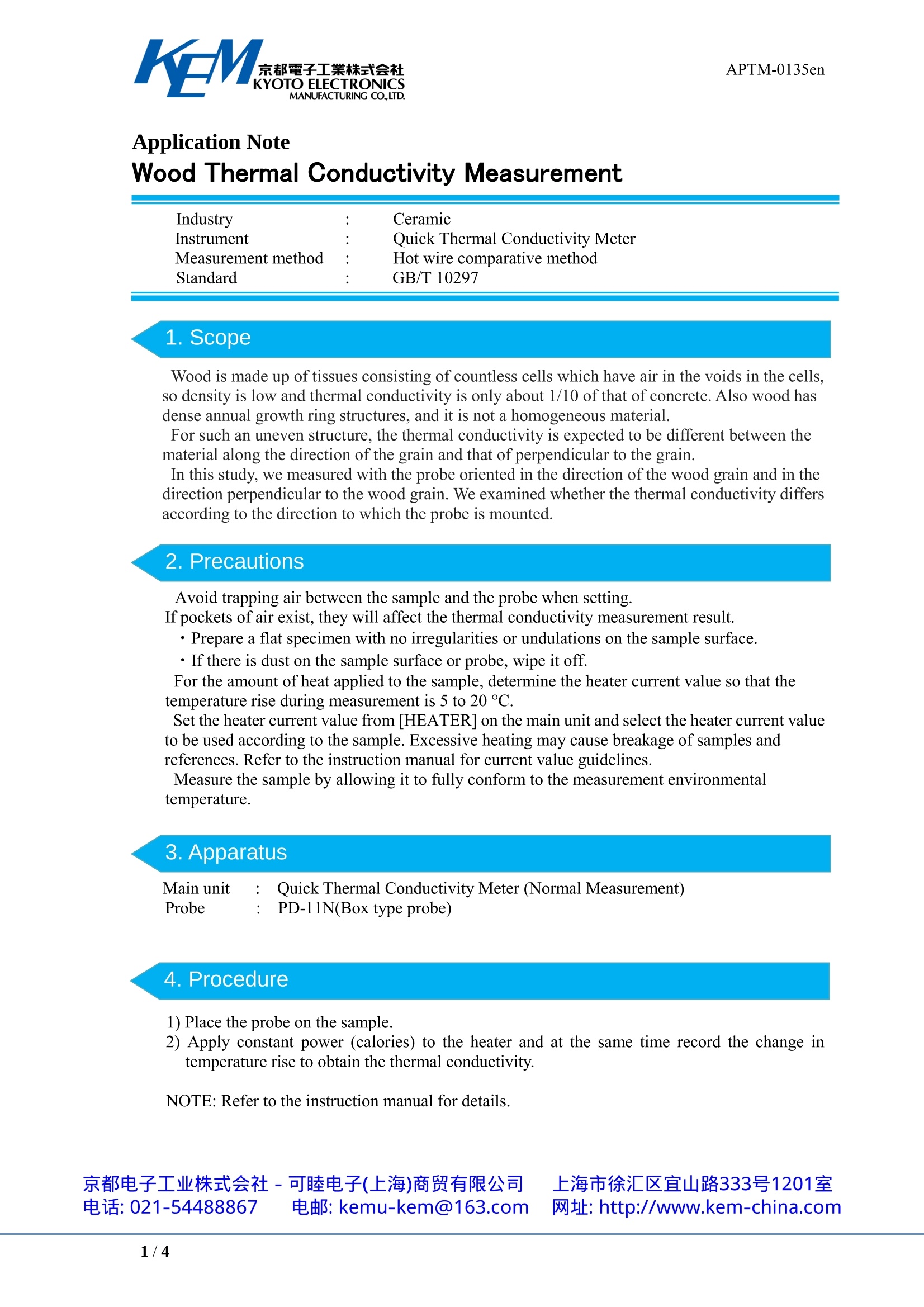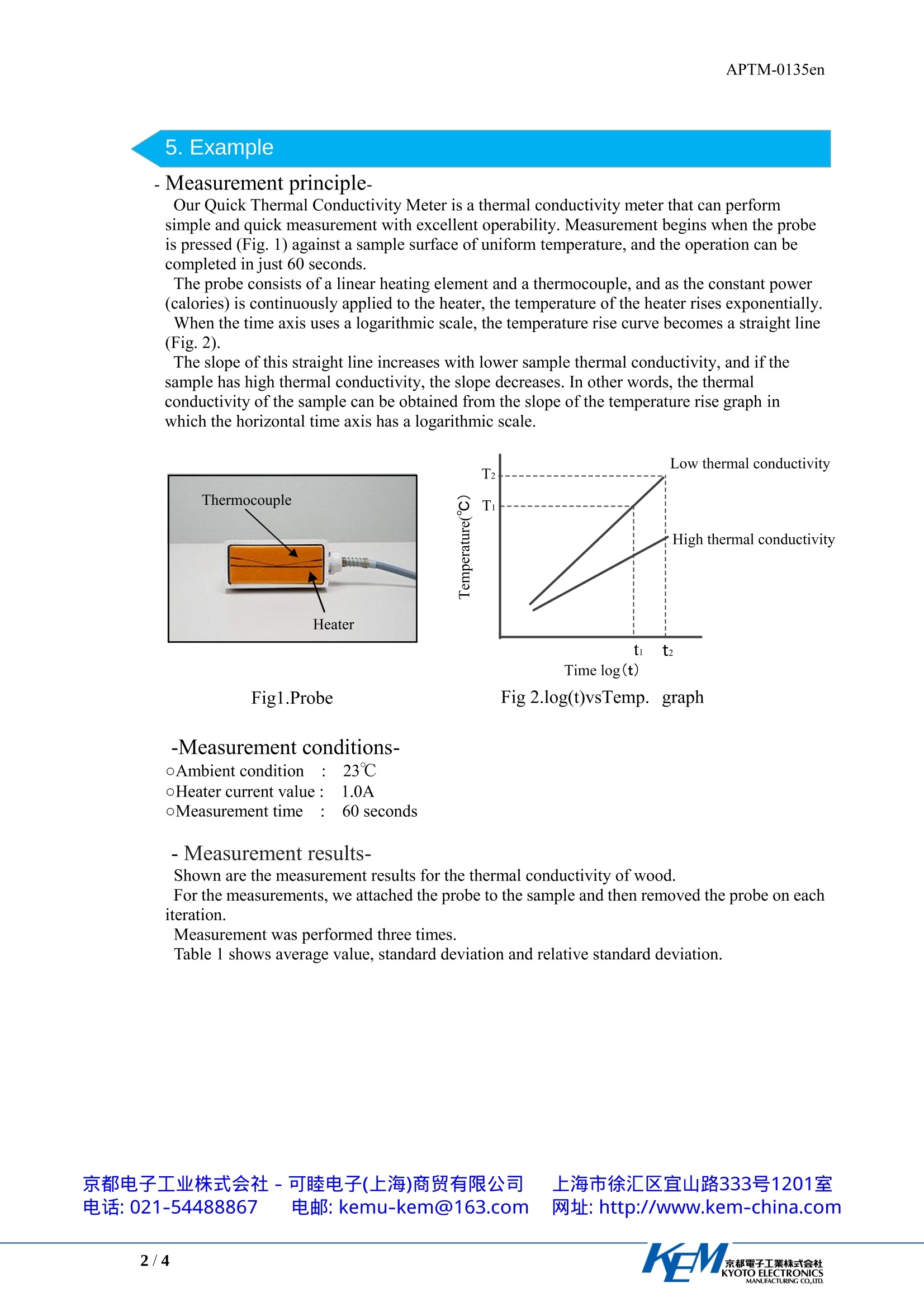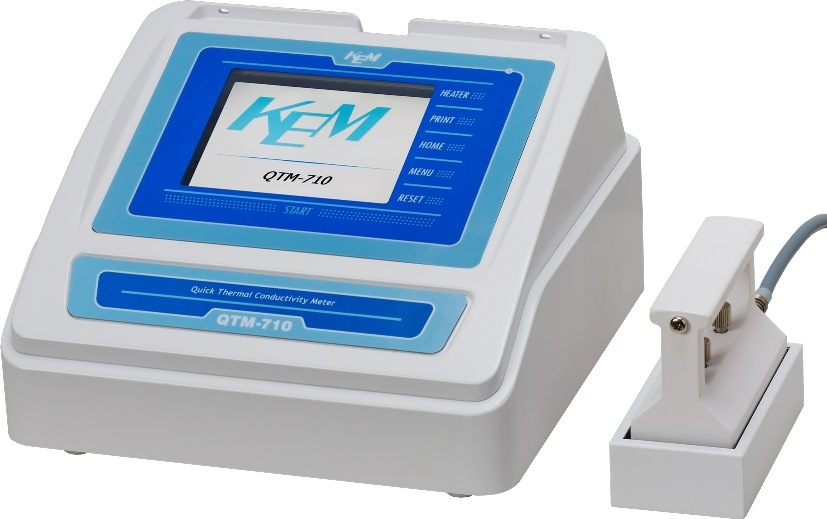方案详情文
智能文字提取功能测试中
木材导热系数的测量 应用资料设置时避免将空气截留在样品和探针之间。如果存在空气,将影响导热系数的测量结果。・制备一个样品表面平整的样品。・如果样品表面或探针上有灰尘,请将其擦掉。对于施加到样品上的热量,确定加热器电流值,以便测量过程中的温升为5至20°C。从主机上的[HEATER]设置加热器电流值,并根据样品选择要使用的加热器电流值。通过使样品完全符合测量环境温度来测量样品。京都電子工業株式会社KYOTO ELECTRONICSMANUFACTURING CO.,LTD.APTM-0135en APTM-0135en Wood Thermal Conductivity Measurement Industry Ceramic InstrumentQuick Thermal Conductivity Meter Measurement method Hot wire comparative method StandardGB/T 10297 1.Scope Wood i s made up of t i ssues consisting of countless cells which have air in the void s in the cell s ,so density i s low and thermal conductiv i ty is only about 1/10 of that of concrete. Also wood has dense annua l growth ri ng structures, and i t is not a homogeneous material. For such an uneven structure, the thermal conductivity i s expected to be different between the material along the direction of the grain and that of perpendicular to the grain. In this study , we measured with the probe oriented in t he direction of the wood grain and in the direction perpendicular to the wood grain. We examined whether the thermal conductivity differs according to the direc t ion to which the probe is mounted. 2. Precautions Avoid trapping air between the sample and the probe when setting. I f pockets of air exist, they will affect the thermal conductivity measurement result. · Prepare a flat specimen with no i rregularities or undulations on the sample surface. · If there is dust on the sample surface or probe, wipe it off . For the amount of heat applied to the sample, determine the heater current value so that the temperature rise during measurement is 5 to 20 °℃. Set the heater current value from [HEATER] on the main unit and select the heater current value to be used according to the sample. Excessive heating may cause breakage of samples and references. Refer to the instruction manual for current value guidelines. Measure the sample by allowing it to f ully conform to the measurement environmental temperature. 3. Apparatus Main uni 1t t Quick Thermal Conductiv i ty Meter (Normal Measurement) Probe PD-11N(Box type probe) 4.Procedure 1) Place the probe on the sample. 2) Apply constant power (calories) to the heater and at the same time record the change in temperature rise to obtain the thermal conductivity. NOTE: Refer to the instruction manual for details. 5. Example - Measurement principle- Our Quick Thermal Conductivity Meter is a thermal conductivity meter that can perform simple and quick measurement with excellent operability. Measurement begins when the probe is pressed (Fig. 1) against a sample surface of uniform temperature, and the operation can be completed in just 60 seconds. The probe consists of a l inear heating element and a thermocouple, and as the constant power (calories) is continuously applied to the heater, the temperature of the heater rises exponentially.When t he t ime axis uses a logarithmic scale, the temperature rise curve becomes a straight line (Fig.2). The slope of this straight l ine increases with lower sample thermal conductivity, and i f the sample has high thermal conductivity , the slope decreases. In other words, the thermal conductivity of the sample can be obtained from the slope of the temperature rise graph in which the horizontal time axis has a logarithmic scale. Low thermal conductivity High thermal conductivity Fig1.Probe Fig 2.log(t)vsTemp. graph -Measurement conditions- oAmbient condition :223℃1 oHeater current value : 1.0A oMeasurement time : 60 seconds -Measurement results- Shown are the measurement results for the thermal conductivity of wood. For the measurements, we attached the probe to the sample and then removed the probe on each iteration. Measurement was performed three t imes. Table 1 shows average value, standard deviation and relative standard deviation. Table 1. List of wood measurement results Wood Measurement point A Measurementpoint B Measurement Measurementpoint D point C Thermal conductivity 0.1106 0.1112 0.1084 0.1628 0.1419 0.2987 0.3135 0.2959 A (W/(mK)) 0.1649 0.1628 0.1434 0.1421 Mean value 0.1101 0.1635 0.1425 0.3027 Standard deviation 0.00147 0.00121 0.00081 0.00946 RSD (%) 1.3 0.7 0.6 3.1 Measurement point A Measurement point B Measurement point C Measurement point D NOTE: Measurement point A:The probe was placed parallel to the wood grain (the heat flow was perpendicular to the grain)Measurement point B:The probe was placed perpendicular to the wood grain (the heat flow was parallel to the grain)Measurement point C:The probe was placed at 45 °℃ to the wood grain (the heat flow was 45°C against the grain) Measurement point D: The probe was placed on a knot in the wood grain. Mo d el: Q TM-710 6. Summar y Good accuracy was confirmed i n which the relative standard deviation of wood was approximately 0.5 to 3.0%. It was also confirmed that the thermal conductivity i s different according to the grain direction,as the thermal conductivity was 0.11 W / m K for the case parallel to grain direction,and 0.16 W /m K for the perpendicular orientation. It was demonstrated that, for a sample whose thermal conductivity differs in one direction to another perpendicular direction, such as wood, changing the set position of the probe with the Quick Thermal Conductivity Meter enables confirmation of the differences i n i n-plane thermal conductivity. For other samples, veri f ication is separately required; i n such cases please consult us as necessary.
关闭-
1/4

-
2/4

还剩2页未读,是否继续阅读?
继续免费阅读全文产品配置单
可睦电子(上海)商贸有限公司-日本京都电子(KEM)为您提供《木材导热系数的测量 应用资料》,该方案主要用于木材/板材中导热系数检测,参考标准《暂无》,《木材导热系数的测量 应用资料》用到的仪器有QTM-710/QTM-700快速导热系数测定仪。
我要纠错
相关方案



 咨询
咨询




